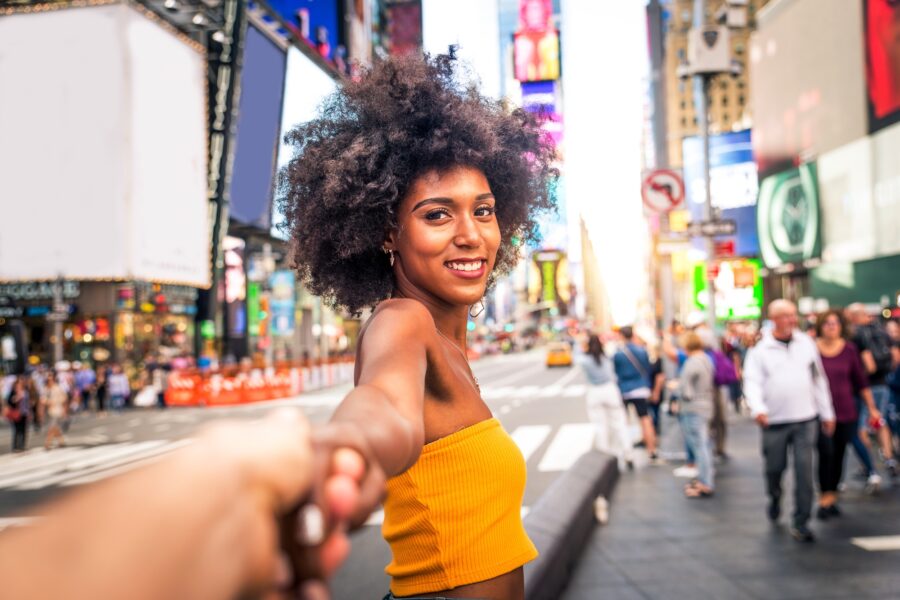New York isn’t just a city; it’s a living, breathing organism that pulses, inhales, and constantly transforms. Within this urban microcosm, a fascinating daily spectacle unfolds: fashion as an expression of freedom. From the cast-iron districts of SoHo to the expansive boulevards of Harlem, the city’s streets serve as an open stage for stylistic experimentation, aesthetic statements, and sartorial self-assertion. Street style in New York isn’t about following trends; rather, it’s about making oneself visible in a world of contrasts.
This reveals a profound cultural phenomenon: clothing becomes armor, poetry, protest. People of all ages, backgrounds, and genders dress as if following an invisible choreography, a choreography born of intuition, conviction, and history. Street style is an aesthetic form of individualization in one of the world’s most densely populated cities. In no other metropolis is clothing so naturally understood as an extension of one’s personality.
It’s not about perfection. On the contrary, the unfinished, the raw, the improvised often defines the city’s unmistakable street looks. Between the hustle and hope, towering skyscrapers and subway stations, a fashion cosmos emerges that defies categorization. To live in or visit New York is to inevitably become part of this rhythmic interplay of forms, colors, and meanings. The street is simultaneously a catwalk and a canvas, a place where visual identity is reinvented daily.
The DNA of New York Street Style
The essence of New York street style lies in its inexhaustible adaptability. There’s no unified formula, no stylistic law defining how to dress in this city and that’s precisely its appeal. In New York, comfort and experimental joy, high culture and subversion, designer pieces and flea market finds merge into a hybrid style that defies convention. Here, clothes aren’t worn to please; they’re worn to tell a story, a biographical narrative woven in fabric, cut, and silhouette.
Characteristic of this metropolis’s street style is the deliberate play with contrasts: luxurious materials meet worn vintage elements, androgynous cuts intertwine with hyper-feminine details, and sportswear is combined with business attire. It’s not about following rules but breaking them with style. Layering, the superposition of various garments, isn’t just practical for changing weather; it’s an expression of layered fashion thinking. Each layer reveals a facet of personality, each look a chapter in the wearer’s urban diary.
Also distinctive is the ability to harmoniously unite opposites: functionality and aesthetics, minimalism and opulence, past and future. New Yorkers’ clothing often interacts with the city’s architecture, pace, and energy itself. A flowing dress against a stark backdrop of concrete and glass becomes a performative gesture; a simple suit in a subway car filled with colors and sounds takes on an almost cinematic effect. Street style is an aesthetic game of contexts improvised, multifaceted, and distinctive. In this city, you don’t just wear clothes, you live them.
Subcultures as Creative Catalysts
New York street style cannot be understood without acknowledging the profound influences of the innumerable subcultures that shape and define the city’s landscape. Every movement, every social group, every artistic scene generates its own visual language, a language guided not by rules but by emotion, history, and community. In Williamsburg and Bushwick, for instance, you encounter a raw mix of DIY punk aesthetics and post-industrial minimalism. Harlem, conversely, is steeped in a tradition-conscious elegance with cultural references reaching back to the Harlem Renaissance.
These subcultural expressions aren’t static; they constantly evolve, rub against each other, and merge. Hip-hop culture, for example, has shaped street style not only through baggy pants and sportswear but through a mindset: pride, resistance, authenticity. The LGBTQ+ community’s ballroom scene brought extravagance, glamour, and gender fluidity to street aesthetics. And notably, art collectives, political activists, student movements, and urban nomads inspire the stylistic language with their own codes from anti-fascist stickers to painted jackets and handmade unique pieces.
New York street style is therefore also a platform for protest and positioning. It gives visibility to those often marginalized in other cities. This cultural density creates a visual complexity that extends far beyond fashion: it reveals how the city’s social fabric is translated into fabrics, colors, and postures. Street style here is lived plurality, a constantly changing mirror of collective and individual belonging. Each subculture is a brushstroke on New York’s vibrant canvas, powerful, wild, and deeply rooted in the urban present.
The Philosophy Behind the Look
Behind the apparent effortlessness of a New York street style outfit often lies a profound philosophical concept. For many in the city, clothing isn’t a mere necessity but a conscious choice, a way of seeing the world, an attitude towards life. The look is a strategy: it can empower, provoke, seduce, or define boundaries. This consciously lived fashion philosophy extends far beyond the visible; it’s a mirror of inner processes, an expression of personal experiences, and a testament to cultural reflection.
In New York, dressing isn’t just about being fashionable; it’s about taking a stance. The body becomes a canvas, daily life a stage, and a message. Whether it’s deliberately chosen vintage pieces, striking prints with a political statement, or subtle yet symbolic accessories everything follows a narrative impulse. The outfit declares: “I am here, I am thinking, I am participating.” Often, this message is subtle, almost ciphered, unfolding only in interaction with the place, the moment, the gaze of the beholder.
At the same time, New York street style refuses the dictate of perfection. It celebrates the imperfect, the experimental, the unfinished. In a fast-paced and contradictory environment like New York, style is never complete; it’s a process, a transformation, a metamorphosis. This philosophy is deeply democratic: everyone has access, everyone can play. There are no clear winners or losers, only individual perspectives that find visible form through clothing.
The Role of Social Media
In an era of digital ubiquity, New York street style has expanded from the physical street into the algorithmic world of social networks. Instagram, TikTok, Pinterest, and Threads now function as digital runways where the city’s visual language is shared and multiplied globally. But the impact extends beyond mere visibility: social media has democratized, fragmented, and simultaneously globalized street style.
What was once documented only by fashion journalists and street photographers is now part of a real-time discourse. Particularly marginalized groups, queer identities, people of color, and independent artists use social media to articulate themselves visually. The street becomes a stage, the outfit a performative gesture. In this environment, micro-trends emerge that are globally received a fashionable ping-pong game between Brooklyn, Tokyo, Paris, and Lagos.
And yet, the creative spark doesn’t ignite in the feed but on the asphalt. Social media amplifies, but it doesn’t replace the magic that only arises when real people make real decisions on real streets visually, politically, artistically.
Street Style as Protest & Art
New York street style is often a silent yet powerful act of resistance. Clothing here is understood not just as an aesthetic statement but as a direct form of political communication. Whether feminist slogans on self-printed shirts, climate messages on recycled jackets, or queer symbolism in color combinations, fashion becomes a medium of social critique.
Simultaneously, this form of expression overlaps with artistic practice. The street becomes a gallery, the outfit a performance, the body a walking installation. This is particularly striking in spontaneous actions, demonstrations, or interactive performances where clothing is not decoration but argument visual, wordless, powerful.
Street Style at New York Fashion Week
New York Fashion Week has long been more than a sequence of exclusive shows in darkened halls; it’s a cultural mega-event that extends beyond the confines of official venues into the urban space. While the latest designer collections are presented on the runways, an equally fascinating spectacle unfolds outside the entrances, on the streets, and in the city’s corridors: the street style of visitors, passersby, photographers, and insiders. Here, fashion reveals itself in its most vibrant, uncensored, and experimental form.
What happens outside the venues is by no means incidental. It’s a stage where people meticulously stage themselves. The outfits worn here are often months in the making, thought out in detail, and frequently charged with a message be it ironic, political, nostalgic, or subversive. New York Fashion Week is thus two-tiered: in the official shows, you see what designers have created for the season on the streets, however, you experience how fashion is lived, beyond commerce and glossy magazines, raw and poetic all at once.
The interplay between official collections and the audience’s looks is particularly exciting. Increasingly, designers are adopting street style, drawing inspiration from real people and their spontaneous combinations. Conversely, what’s seen on the runways influences how visitors dress throughout the week. A dialogical space emerges where fashion no longer functions only top-down but circulates from studios to the street and back.
In this context, street style becomes a social archive: it documents not only aesthetic tendencies but also the cultural moods of an era. Which messages dominate? Which silhouettes return? Which fabrics and patterns carry political energy? The sidewalk in front of the showroom thus becomes a resonating chamber for zeitgeist, belonging, and artistic visions.
New York Fashion Week wouldn’t be what it is without this outer space without the fashion that’s not based on invitation but on attitude. Street style during these days is the true pulse of the fashion world: unpredictable, dynamic, polyphonic. It celebrates individuality over uniformity and shows that fashion can operate beyond status and brand power as a pure manifestation of personality, courage, and presence.
Street Style & Art – Mergers
Few cities embody the fusion of fashion and art as intensely as New York. On its streets, the boundary between wearable clothing and artistic expression is not merely permeable; it often ceases to exist. Street style becomes performative practice, the body a canvas, and the street a gallery without walls. In this atmosphere, visual works are created that consist not of brushstrokes or sculptures but of fabric, silhouettes, colors, and attitudes.
Numerous outfits appearing on New York’s streets are far more than fashion statements; they are wearable artworks. Individual garments are treated like artifacts: alienated, reworked, painted, cut, reconstructed. Many fashion players work at the intersection of design and fine art, drawing from performance art, installation, painting, and photography. The aesthetic often draws inspiration from artists like Louise Bourgeois, Cindy Sherman, or Jean-Michel Basquiat not as mere quotations but as an adoption of artistic attitude.
Material choice plays a central role: upcycled fabrics, industrial materials, transparent textiles, or organic-looking structures create a new visual language. Clothing is no longer evaluated by the criterion of wearability but by its expressiveness, its ability to provoke, and its emotional impact. The wearers of such looks aren’t models, they are artists of their own appearance. Every step through the streets becomes a performance, every eye contact a moment of interpretation.
Interactions with the urban space itself also allow the artistic character of street style to flourish. Clothing deliberately harmonizes or contrasts with its surroundings: a brightly colored coat against gray concrete, a gold-embroidered caftan in the twilight of a subway station; these are not coincidences but finely tuned visual compositions, often documented photographically and multiplied on social media.
New York street style is therefore not merely an expression of individual creativity but part of an urban art movement that constantly transforms itself. It is a living critique of conformity, a fashionable response to institutional limitations, a rebellion against the fleetingness of consumerism through the enduring nature of expression. In its most powerful moments, it even transcends the term “fashion” and enters the realm of art rebellious, poetic, transcendent.
Typical Elements and Visual Codes
New York street style may seem unpredictable, but upon closer inspection, characteristic features emerge visual codes that function like secret languages. It’s not individual trends that matter but the way elements are combined, contextualized, and worn. The typical look thrives on the play of opposites: a tailored blazer over a worn band t-shirt, chunky sneakers with a delicate dress, high fashion paired with second-hand finds. This style is deliberately unbalanced, and that’s precisely where its power lies.
A central feature is the principle of layering. Layering is not only a response to the city’s changeable climate but an expression of an aesthetic principle. Each garment is part of a narrative, an identity, a constant transformation. Accessories are not understood as mere embellishments but as an integral part of the statement: large glasses, unusual hats, bags with political embroidery, or custom-made jewelry. Often, these details transform an outfit from ordinary to meaningful.
Color combinations also often follow an internal logic that only reveals itself upon closer inspection: stark contrasts, monotonous gradations, precisely placed accents. And then there are materials that tell stories: shiny patent leather, worn denim, wrinkled cotton, glittering tulle, recycled plastic foils. These textures create tensions and associations that go far beyond the visual. They make the outfit tactile, experiential, almost sculptural.
New York street style knows no single silhouette; it loves diversity: oversized shirts, form-fitting bodysuits, androgyne cuts, extra-long coats, asymmetrical constructions. And above all: attitude. Because what ultimately holds every outfit together in this city is not the brand, the cut, or the budget, but the self-perception of the wearer. Clothing becomes a second skin, a mirror of inner states, a means of communication in a world where everything is visible and everything carries meaning.
The Geography of Street Style
New York is a city of neighborhoods and each possesses its own distinct fashion character. Street style in SoHo differs fundamentally from that in Bushwick, Chelsea, Harlem, or the Lower East Side. The city’s geography directly influences its fashion: it shapes not only paths and movements but also aesthetics, atmospheres, and identities. In a way, street style is a cartographic practice that inscribes itself into the city’s topography and makes urban spaces legible.
In Brooklyn, for example, a consciously experimental, often art-inspired aesthetic dominates. Here, you see recycled materials, vintage finds, and deliberately raw combinations. In Manhattan, the look is often more polished, stylistically defined, with influences from the international business and fashion environment. Harlem unites African-American elegance, hip-hop heritage, and community pride. The Lower East Side, however, remains an epicenter for punk and DIY culture. Each of these places tells its own story through its clothing of social movements, economic upheavals, migration, resistance, and innovation.
This fashion geography is not static. It changes as neighborhoods change through gentrification, influx, marginalization, or revitalization. Street style reacts immediately to these processes: it preserves old images, generates new narratives, resists or adapts. The outfit thus becomes an urban chronicle visual, social, political. Walking through New York’s streets means reading more than fashion. It means reading history.
The Influence of the Seasons
Few cities live as strongly in the rhythm of the seasons as New York and its street style remarkably reflects these changes. Spring signifies new beginnings, color, lightness. Skirts flutter through the streets, pastel accents greet the first sunbeams, and the layering look gains a new, airy vocabulary. In summer, casual fabrics, sporty silhouettes, transparent materials, and bold declarations of skin dominate. The body becomes visible, clothing becomes a second skin light, breathable, sensual.
In autumn, however, the mood shifts. Colors become earthier, cuts more structured, fabrics heavier. Oversized jackets, scarves, hats, and structured shoes gain significance. The look becomes more multifaceted, contemplative, almost poetic. Winter, finally, presents the ultimate challenge: style and function must enter a symbiosis. Puffer jackets, layered constructions, thermal fabrics, leather, knits, hats all become creative building blocks of a look that not only protects but also communicates.
What makes New York street style so special is its ability to not be limited by the weather but to integrate it. Rain, heat, snow, wind all become part of the fashion expression. Seasons here are not obstacles but inspirations. They lead to seasonal micro-trends, influence color choices, textures, and accessories. In no other city do you see how stylishly one can cope with a snowstorm or a 40-degree heatwave. Street style adapts without losing itself. It remains true to itself, even amidst change.
A Glimpse into the Future, The Future of Street Style in New York
New York’s street style has never been static and it won’t be in the future either. Given global challenges such as climate change, digital saturation, political polarization, and identity discourses, street fashion will continue to transform. We will increasingly see sustainable materials, garments with tracking functions, digitally generated accessories, or looks that originated entirely in virtual spaces. Yet, despite these developments, one thing will remain: the human at the center.
The future of New York street style lies in the connection of technology, sustainability, and personality. Clothing will become an interactive medium, an ecological statement, an extension of digital identity. But the more virtual the world becomes, the stronger the desire for authenticity, for texture, for lived presence. Street style will have to reinvent itself between screen and sidewalk, between algorithm and authenticity.
What endures is the rebellious spirit. The attitude that every look is a personal manifesto. That fashion is a language that needs no words. That even in times of global crisis, beauty, creativity, and expression are not just possible but necessary. In a world of change, New York street style is a promise: of visibility, of diversity, of the future.









